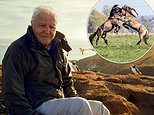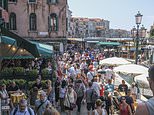
The world’s greatest traveller is coming home. Sir David Attenborough, who has filmed in every corner of the planet during more than 60 years in broadcasting, has chosen the British Isles for his most poignant wildlife series yet.
At the grand age of 96, the revered film-maker is still out exploring — not only narrating but appearing on camera in each of the five episodes of Wild Isles, a trademark natural history spectacular touring the UK and Ireland, and out on the BBC next month.
Sir David will say in the series: ‘I have travelled the world, I have seen the planet’s greatest natural spectacles, and I can assure you that in the British Isles there is drama and spectacle to match anything I have seen in my other adventures.’
Producer Alastair Fothergill, who has worked closely with the veteran broadcaster for more than 35 years, agrees: ‘People don’t realise how rich Britain is in wildlife. We have 22,000 miles of coastline, and so an enormous number of seabirds.
‘We have more ancient oaks than the rest of Europe in total, half the world’s common bluebells, a quarter of the badgers, more than 80 per cent of the world’s chalk streams. But we are in real danger of losing it all.’
Sir David Attenborough has chosen the British Isles for his most poignant wildlife series yet (Pictured at Skomer Island)
Horsing around: Wild horses have been re-introduced to the Cambridgeshire fens, not only because they are magnificent animals but because they are so important to the habitat. Their hooves churn up the ground, encouraging plants and insects to thrive
Call of the wild: Red deer during the rutting season. They have been doing battle here for at least 6,000 years and their distinctive bellow can be heard for miles around (Killarney)
This will be emphasised in a sequence filmed in a Dorset hay meadow where Sir David talks to camera in a sea of wild flowers. It’s a sight that was common in his youth, he says, when he roamed the Leicestershire countryside on his bicycle looking for wildlife. But today, we have lost 97 per cent of our wild flowers, and much of the insect, bird and animal life that thrived among them.
The first episode will tackle this eco-crisis, with subsequent programmes looking at life in woodlands, freshwater, grasslands and the sea.
These pictures, though not all taken from the show itself (which is still under wraps), give a tantalising hint of what’s ahead. One breath-taking segment will feature peregrine falcons diving on wading birds called knots. ‘Knots are migratory,’ says Alastair.
‘They come down from the Arctic in such great flocks that the falcons have a problem.
‘It’s harder for them to identify a single target when there are tens of thousands. There’s safety in numbers.’
Another dramatic battle will play out on a smaller scale.
‘One of my favourite sequences,’ says Alastair, ‘shows leeches hunting toads. These little killers are no more than 15cm long, but they are extraordinary predators.
‘If you loved the shots of racer snakes chasing newly hatched iguanas in the Galapagos Islands on Planet Earth II, you’ll be equally transfixed by the leeches.’
Flight of fancy: After weeks of waiting, patient crews have captured sea eagles taking barnacle geese on the wing, the way sparrowhawks pounce on much smaller birds (Pictured: Hebrides)
What a carve-up: These pillars of chalk in Dorset’s Studland Bay — one of our coastlines’s most remarkable sights — were shaped by the sea over millennia (Pictured: Old Harry Rocks)
It’s in the can: Underwater drones will capture salmon migrating upstream (Pictured: Perthshire)
A whale of a time: Orcas in Shetland stun their prey using their powerful tails leaving the seals helpless
However, his favourite creature in the series is perhaps the smallest of all: the mason bee. ‘It lays its eggs in an empty snail shell and carries bits of vegetation to build a protective teepee over the shell,’ he explains.
‘Clutching a twig in its legs, it looks as if it’s riding a broomstick. Imagine that — a bee that looks like it’s Harry Potter!’
And yet the magic in the series is not make-believe. From the Scillies to Shetland, Wild Isles will span almost every corner of these great islands, revealing a very real and thriving natural world right on our doorstep.
Source link
CHECK OUT: Top Travel Destinations
READ MORE: Travel News



